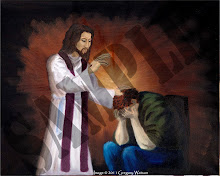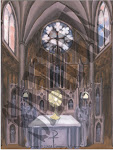We interrupt our regular broadcast schedule to bring you some seminal thoughts in honour of the Feast of Our Lady of Guadalupe
Edit:Added the image of Our Lady, and a comment regarding the title she revealed herself under.

In the December of 1531, the Blessed Virgin Mary appeared to a native convert to Catholicism, named St. Juan Diego, in what is now Mexico City. On the ninth of December, she told him to tell the Bishop that she wanted a church built on the hill where they were (called Tepeyac). The Bishop didn't believe Juan, and dismissed him. On the way home, Our Lady met Juan again, and he related to her what had happened, asking her to send someone else, who was more learned and sophisticated. She replied that while she had many she could ask to do her will, "It is necessary for every reason that you yourself solicit and help." So the next day, St. Juan Diego went to the Bishop again, who again refused to believe him, but, impressed by his forthrightness and simplicity, asked Juan to ask Our Lady for a sign of confirmation. So Juan left the Bishop and again encountered Our Lady on top of Tepeyac hill. He asked for the sign, and she promised him that if he returned the next day, on the 11th, she would provide one for him.
When Juan returned home, however, he found his uncle, Juan Bernardino, deathly ill. He stayed with his uncle the whole next day, but on the twelfth, his uncle sent him to fetch a priest to administer the Last Rites. While Juan was on the way, he remembered Our Lady, and went around Tepeyac seeking to avoid her, not because he didn't wish to complete her task, but because he wanted to take care of his uncle first. The Virgin Mary, however, came down the hill and met him on the way, asking why he had failed to come to her. Having explained about his dying uncle, she assured him that his uncle was already cured of the terminal illness, and sent him to the top of the hill to collect the promised sign. Later, St. Juan Diego would find out that Our Lady appeared to his uncle at that very moment and healed him. She also revealed to Juan Bernardino her title, Our Lady of Guadalupe. Why Guadalupe? Actually, it's a phonetic equivalent in Spanish of the Nahuatl word, Coatlaxopeuh, which means, "I smashed the serpent with the foot," recalling God's promise of redemption in Genesis 3:15.
Mary instructed Juan to go and pick the flowers he would find growing at the top of the hill--and there, in a barren, rocky place, in the dead of winter, he found beautiful Castillian roses growing, roses not native to Mexico, but very familiar to the Spanish bishop. After he had gathered them up, she herself arranged them in his tilma, a mantle made of cactus fibre, and told him not to open the tilma to anyone but the bishop. When he arrived at the bishops house, the servants, tiring of his frequent visits, refused to let him in until he showed them what was in his tilma, but because of Our Lady's instruction, he refused. Finally, the bishop was summoned, and St. Juan opened his tilma, letting the roses fall to the ground. But the miracle didn't end with the roses, for on the tilma was the image of Our Lady as she had appeared to St. Juan Diego. The bishop fell to his knees weeping in remorse for not having believed Juan immediately, and took the tilma to his own private chapel. He commissioned the chapel to be built on Tepeyac, and when it was complete, placed the tilma with the image above the altar. Within ten years of the chapel's construction, nine million natives had converted to Christianity!
This conversion brought about major changes to Mexico. At that time, the natives viewed the Spanish with great distrust, and the Spanish, for their part, had refused to acknowledge that the natives even had real human souls. With the appearance of Our Lady to Juan Diego, hostilities ceased, and peace reigned between the Spanish and the natives, forming a new race of "Mestizo", who still to this day consider Our Lady their Mother. Further, with the natives' conversion to Christianity, their fear-filled religion of human sacrifice was done away with. A culture of death, sacrificing tens of thousands of people to their gods in order that they would be blessed with prosperity, suddenly found themselves in the care of a loving God who Himself provided the only Sacrifice they would need, in His Son.
Now, nearly 500 years later, the cactus-fibre tilma still exists, and the image still is on it. It has survived the elements, accidents, and outright attempts to destroy it (such as a bomb blast by anti-clerical forces in 1921 which decimated the entire church, but the tilma remained intact). Miracles continue to be wrought at the most visited Marian shrine in the world, as healing was worked in the case of Juan Bernardino, and Our Lady continues to reveal that her Son truly is Emmanuel--God-with-us.
The image of Our Lady has been studied repeatedly, and found to have no human explanation. Moreover, there are elements that would have been unthinkable to portray by a human artist--such as the reflection of the bishop and servants in the eyes of Our Lady, as revealed by ophthamological studies. But the image itself is a message, having not simply the image of Our Lady radiating the light of God as Revelation 12 describes, but her garment is covered with Aztec heiroglyphs, among which is the symbol for the infinite, transcendent, all-powerful God, right over her pregnant belly. In other words, the image told the native Mexicans, as it tells us, that Jesus is the Infinite, Transcendant God, but that He loves us and makes Himself intimately Present to us.
Throughout the world, thousands upon thousands of people are brutally and savagely murdered in what should be the safest place in the world for them--all in the name of convenience and prosperity. Similar to that perpetrated by the Spaniards upon the native Mexicans, this mass murder is perpetuated with the excuse that these people aren't really people anyway--that they thus don't have the right to live.
They are the unborn. They are the human sacrificial victims of our culture of death's worship of the gods of lust, convenience, libertarianism, and prosperity. They are the victims of the lying gods whose names are "Freedom" and "Choice"--otherwise known as Moloch and Tláloc.
The children are not the only victims. No one is untouched by this travesty. The mothers, especially, are wounded incredibly. Often the "choice" they make is not a choice at all, but they are pressured by all sorts of sources, be it their husband or boyfriend, their parents, even their workplace. Abortion has been shown to lead to severe depression, reckless behaviour, accidental and violent deaths, and even suicide. The lying gods do not bring "freedom" through "choice", but only repay death for death.
Just as Our Lady crushed the serpent's head, and brought an end to human sacrifice in Mexico, she desires the end of the culture of death rampant in the world today. She calls us continually to turn to her Son in prayer and penance, and to speak out against the culture of death, with the Gospel of Life. Especially during this season of Advent, as we await the Birth of Christ, the Virgin of Guadalupe shows herself as a pregnant Mother, who herself was an unwed pregnant girl in a society where such a scandal could have cost her her reputation, her freedom, even her own life. Yet she gave her Fiat to God, "Let it be unto me according to your word" (Luke 1:38).
We too must respond in faith, hope, and especially love. We are not called simply to defend the unborn, but to aid frightened, hopeless mothers and their families in their distress. The Culture of Life reaches out to everyone at every stage of life, bringing God's promise of hope and help to their lives. We must each do our part to reach out in love to those trapped by the culture of death. Our Lady's words to St. Juan Diego apply to us today, as well: "It is necessary for every reason that you yourself solicit and help."
God bless,
Gregory
The Feast of Our Lady of Guadalupe
(For a more detailed account of the story of Our Lady of Guadalupe and the miraculous image, click here.)






